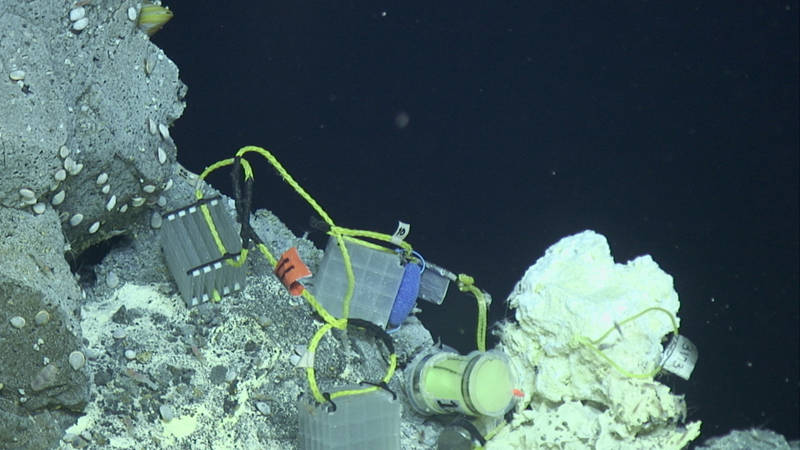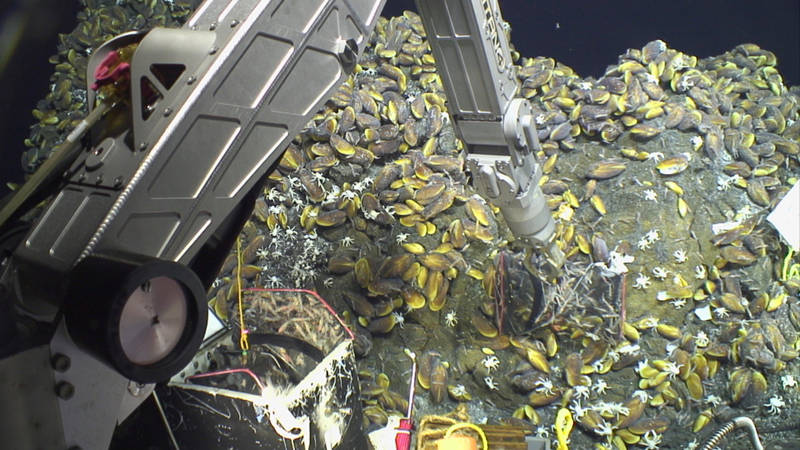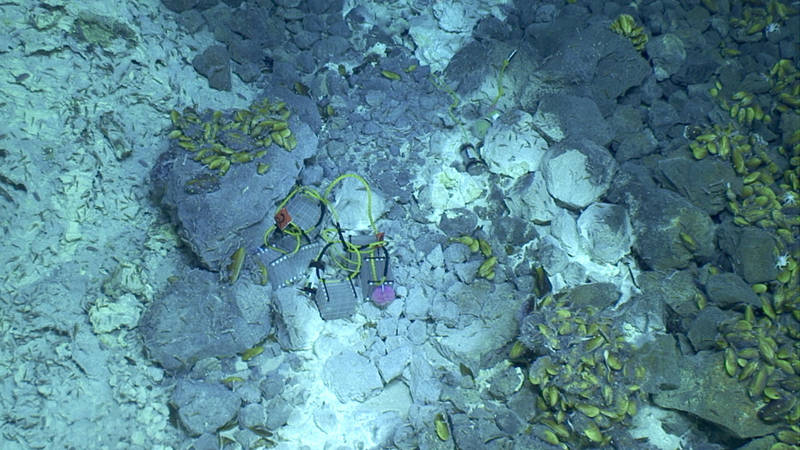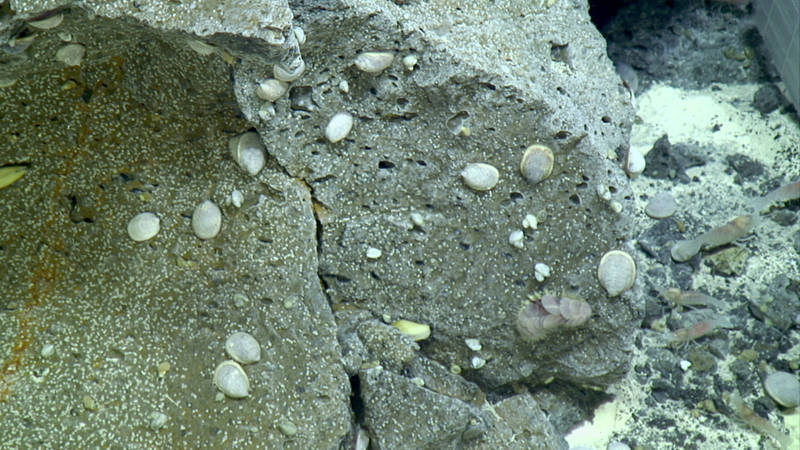
By Shawn Arellano - Western Washington University
December 16, 2014
NW Eifuku: Final Dive. Video courtesy of Submarine Ring of Fire 2014 - Ironman, NSF/NOAA, Jason, Copyright WHOI. Video produced by Saskia Madlener. Music by Charlie Brooks. Download (mp4, 42.6 MB)
A fundamental question in marine ecology asks why organisms live where they do. An animal’s distribution can be explained by how they are affected by the physical (abiotic) environment and by other organisms (biotic environment). Thus, if you go to the coast in the tropics, you would encounter a very different biological community than you would in a temperate region because organisms that live in these places have to contend with two very different environments.

Settlement plates that were deployed on our first dive at NW Eifuku are recovered to see what animals may have settled on them since then. Image courtesy of Submarine Ring of Fire 2014 - Ironman, NSF/NOAA, Jason, Copyright WHOI. Download larger version (jpg, 1.0 MB).
Even on a smaller scale, you can see distinct patterns in biological communities based on their interactions with the environment and each other. For example, if you have ever been to a rocky coastline on the west coast, you probably have seen the distinctive banding pattern of organisms in different intertidal ‘zones.’
The unique geochemical processes that occur on the Mariana arc and back-arc lead to a lot of variation in abiotic characteristics from seamount to seamount. So I was not surprised to see a different suite of animals at NW Eifuku than we did at the Snail site in the southern Mariana back-arc on our first dive. However, during our dives at NW Eifuku, I was struck by the clear ‘zones’ of animals within one seamount.

Jason recovers two shrimp traps that were deployed during our first dive at NW Eifuku. Image courtesy of Submarine Ring of Fire 2014 - Ironman, NSF/NOAA, Jason, Copyright WHOI. Download larger version (jpg, 1.1 MB).
A point of clarification: the area that we visited at NW Eifuku was not all that big. Within an area about the size of a couple of football fields there are more than a dozen venting sites that we visited. As we travelled from site to site, we would see different kinds of communities: beds of mussels covered with shrimp and small limpets, big yellow cones of iron mats that hosted a different species of shrimp and large scaleworms, sulfur crusts and basaltic andesite rocks covered with big limpets. Even within one community type, we could see distinct distributional patterns among the animals.
One thing I am particularly interested in is how hydrothermal vent organisms select just the right place to live. For example, we found a lot of large limpets (Shinkailepas sp.) living on rocks in areas of diffuse vent flow.

Settlement plates were also recovered from the Champagne vent area. Here, shrimp graze on sulfur (left), while mussels prefer to live on the rocks (right). Image courtesy of Submarine Ring of Fire 2014 - Ironman, NSF/NOAA, Jason, Copyright WHOI. Download larger version (jpg, 1.4 MB).
Fluid chemistry and rock type also vary a lot at these sites and both of these things probably play a big role in structuring the distribution of organisms. How did the limpets find the right rock type with just the right vent flow? For a more mobile animal like the shrimp, one could imagine that they could just swim around, ‘looking’ for the right place. But limpets can only swim when they are babies (larvae), and even then they do not swim well enough to fight against the currents. To avoid getting wafted away to a nearby vent that may not have the right habitat, limpet larvae could have some special mechanisms to retain themselves near their adult home. For instance, work on a previous Submarine Ring of Fire cruise showed that the limpet larvae swim very close to the bottom where they might be able to avoid strong currents.

A basaltic andesite rock at NW Eifuku is covered with Shinkailepas limpets and thousands of their tiny egg capsules (white dots). One side note about these limpets: like the mussels at NW Eifuku, these limpets had paper thin shells! Image courtesy of Submarine Ring of Fire 2014 - Ironman, NSF/NOAA, Jason, Copyright WHOI. Download larger version (jpg, 1.4 MB).
On this cruise, I hope to investigate whether the larvae are good at sensing and selecting the right physical habitat. I’ll do this by collecting rocks that are covered in egg capsules and rearing the larvae in the lab for experiments on what might cue them to settle down. Each of these egg capsules that I have collected releases perhaps 40 or 50 larvae and dozens of capsules can release in a day, meaning I spend my days on the ship caring for hundreds of limpet babies at a time!
A final cruise note—now that we have been living on the ship for more than two weeks, some of us are missing a few creature comforts from home. Among the items that my fellow scientists have said they are now wishing they would have brought with them are: sandals (it’s hot outside here!), a sweatshirt (the Jason van is cold!), more chocolate (of course), their own pillows, earplugs (the bow thruster is loud!), nail clippers, cold medicine, their Christmas stockings, and a guitar to get in some practice when we are waiting on weather.
The Limpets of Northwest Eifuku. Video courtesy of Submarine Ring of Fire 2014 - Ironman, NSF/NOAA, Jason, Copyright WHOI. Video produced by Saskia Madlener. Music by Charlie Brooks. Download (mp4, 14.0 MB)